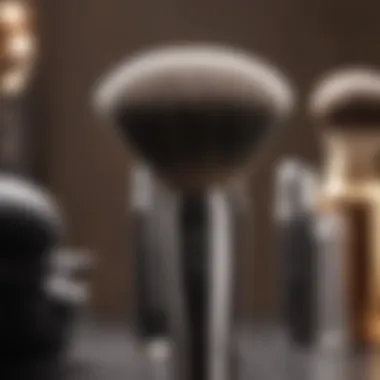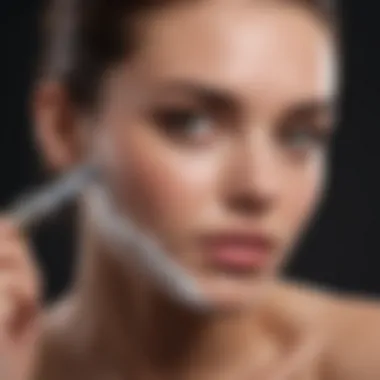The Ultimate Guide to Shaving Your Lady Parts Safely


Intro
Navigating the world of personal grooming, particularly in sensitive areas, requires knowledge and precision. Shaving the intimate area is a common practice for many women, yet it often carries risks of irritation, cuts, and discomfort if not approached correctly. This guide aims to provide insightful tips and practical steps for a safe and effective shaving experience. It discusses the methods available, the tools needed, and the hygiene practices essential for maintaining skin health. With a focus on aftercare and ongoing maintenance, this piece will serve as a reliable resource for individuals seeking to enhance their grooming routine.
Beauty Tips and Tricks
Skincare Routine Tips
Before embarking on the shaving process, it is crucial to prepare the skin. Here are some skincare tips:
- Exfoliation: Gently exfoliate the area a few days before shaving. This removes dead skin cells and helps prevent ingrown hairs.
- Hydration: Keeping the skin well-hydrated is vital. Moisturize the area regularly to maintain skin elasticity and health.
- Timing: Consider shaving after a warm shower. The heat and steam help to soften hair and open up pores, facilitating a smoother shave.
Haircare Hacks
While this section primarily focuses on shaving, keeping hair growth in check can aid the process:
- Trimming: If the hair is long, trim it before shaving. This reduces the risk of clogging the razor and makes for a more efficient shave.
- Growth Direction: Be aware of the hair growth direction. Shaving in the direction of growth can minimize irritation and help achieve a closer shave.
Makeup Application Techniques
Though not directly related to shaving, understanding skincare can enhance post-shave care:
- Post-Shave Care: After shaving, apply a soothing lotion free from harsh fragrances. This can alleviate irritation and provide needed moisture.
Expert Beauty Advice
- Professional Makeup Artist Insights: Seek advice from experts on how to maintain the skin in sensitive areas. Makeup artists often have skincare tips tailored for delicate areas.
- Skincare Specialist Recommendations: Dermatologists can recommend pH-balanced products to use before and after shaving. Their insights can be invaluable in preventing discomfort.
- Hair Stylist Tips: Professionals can suggest the best tools for hair removal and recommend techniques for maintaining healthy skin between shaves.
Finale
Shaving the intimate area is a personal choice that can benefit from informed decision-making. Understanding the proper techniques, preparation methods, and aftercare routines can transform the experience from one of anxiety to comfort. Keep in mind the importance of hygiene and always prioritize skin health. This guide provides a thorough foundation for safe shaving practices, but individual experiences may vary. If unsure, consulting a specialist is always a prudent choice.
Understanding the Importance of Grooming
Grooming is not merely a choice; it reflects personal hygiene, cultural values, and self-respect. The act of grooming the intimate area carries implications for health and well-being. Many individuals find that maintaining this area contributes to a feeling of cleanliness and confidence. It can help prevent discomfort and skin issues, which is critical for comfort in daily life. In this article, we will explore different facets of grooming and its broader impact.
Cultural Perspectives on Grooming
Grooming habits vary widely across cultures. In some societies, hair removal is seen as a standard part of beauty, whereas in others, it might be viewed as unnecessary or even discouraged. These cultural perspectives shape individuals’ choices and experiences regarding their grooming routines.
Historically, the motivations behind grooming have often been tied to social and cultural norms. For example, in many western cultures, pre-shaving rituals became more prominent in the last few decades. In contrast, certain societies celebrate natural forms of body hair. Awareness of these cultural contexts makes discussions about grooming more nuanced and respectful. Recognizing differing values helps individuals choose their grooming practices more wisely, based on what feels right for them.
Health and Hygiene Considerations
From a health standpoint, proper grooming is essential. The intimate area is prone to irritation, infections, and ingrown hairs. By keeping the area well-groomed, individuals can reduce the risk of such conditions. It is crucial to maintain hygiene while shaving. This includes using clean tools, applying the right products, and being aware of skin sensitivity.
An additional benefit of grooming is the psychological aspect. Many people feel a boost in confidence, which can positively influence self-esteem. Engaging in a grooming routine can become a form of self-care, enhancing overall emotional well-being.
Grooming practices should be tailored to each individual's skin type and preferences. Skin that is sensitive may require more careful handling, emphasizing the need for proper techniques and suitable products.
"The importance of grooming is not just aesthetic; it also plays a vital role in personal health and hygiene."
Preparing for the Shave
Preparing for a shave is an essential part of the process that can significantly affect the outcome and comfort of the experience. Understanding how to prepare properly ensures not just efficiency but also helps in reducing potential irritations or other complications. This section will guide you through the critical pre-shaving steps to create the best environment for a smooth shave.


Choosing the Right Time
Timing is a critical element when preparing to shave. The optimal time to shave varies based on individual skin types and personal schedules. For those with sensitive skin, shaving after a warm shower may be an excellent choice. Warm water helps to soften the hair and open up the pores, leading to a more comfortable shave.
Moreover, choosing a time when you will not feel rushed can enhance the shaving experience.
Essential Tools and Products
The importance of the right tools and products cannot be overstated. They directly influence the shaving process and the condition of the skin post-shave.
Razor types
Selecting the appropriate razor is a significant decision. There are various options, such as disposable razors, safety razors, and electric razors. Each has its strengths. Disposable razors are often convenient and cheap but may not provide as clean a shave compared to safety razors, which allow for more control. Electric razors can be a quicker solution, though they may not deliver as close a shave. Knowing the unique characteristics of each type aids in making an informed decision that aligns with personal preferences.
Shaving cream or gel
Using shaving cream or gel plays a major role in reducing friction during the shave, which helps to minimize irritation. A quality shaving cream or gel contains moisturizing agents that can hydrate the skin and create a barrier between the skin and razor. This not only improves comfort but also contributes to a closer shave. Always opt for products that are hypoallergenic for sensitive skin when those are concerns.
Moisturizer
Moisturizing post-shave is crucial for overall skin health. A good moisturizer helps to maintain hydration levels of the skin and aids in recovery from any irritation caused during shaving. Look for moisturizers that contain soothing ingredients such as aloe vera or chamomile, as they provide additional benefits in calming the skin. Adequate moisturization can prevent issues like dryness or flakiness that might occur after the shaving process.
Skin Preparation Techniques
Taking the time to prepare the skin will ensure not only a smoother shave but also promote skin health in the long run.
Cleansing
Cleansing is one of the first steps in skin preparation that should never be overlooked. Using a gentle cleanser will remove any dirt or oil from the skin's surface, allowing for a cleaner shave. This step is particularly important as it helps to prevent the risk of infection or irritation from dirt that may get trapped during shaving.
Exfoliating
Exfoliating prior to shaving can be highly beneficial. It removes dead skin cells that might clog the razor, leading to a smoother experience. Gentle exfoliators can be used to prepare the area effectively without causing irritation. However, caution should be taken not to over-exfoliate as it may lead to increased sensitivity when paired with shaving.
Taking these preparatory steps can significantly enhance your shaving experience. Ensuring the right tools, a suitable time, and a focus on skin care can lead to better results and a better sense of comfort.
Shaving Techniques
Understanding the right shaving techniques is crucial for ensuring a smooth and irritation-free experience when grooming the intimate areas. Different techniques affect the results and comfort level, making it essential to apply the correct one based on your skin sensitivity and hair type. Addressing direction, patterns, and sensitivity can transform your shaving routine into a more pleasant and effective practice.
Choosing the Right Direction
Against the grain
Shaving against the grain means moving the razor blade in the opposite direction of hair growth. This technique is known for delivering a closer shave, which many individuals may prefer for a smooth finish. The main characteristic of this method is its ability to capture hair more effectively, ensuring fewer missed spots and a cleaner look. However, while the benefit of a closer shave is attractive, it comes with certain risks as it may lead to increased irritation or the likelihood of razor burns. For sensitive skin, this approach necessitates careful consideration and perhaps less pressure while shaving.
With the grain
Shaving with the grain involves moving the razor in the same direction as the hair grows. This technique is often recommended for those who experience sensitivity or irritation after shaving. The key characteristic here is its gentleness, which mitigates the risk of nicks and cuts, resulting in a more comfortable experience overall. Shaving with the grain can be less effective for achieving an extremely close shave, but it allows for a more manageable grooming routine for those with sensitive skin or a shaving history of irritation.
Shaving Patterns and Methods
Short strokes
Using short strokes while shaving can offer better control and precision. This technique involves making swift, small passes with the razor. Its primary advantage lies in the ability to navigate challenging areas, promoting more accurate results without overwhelming the skin. For beginners or those unfamiliar with their anatomy, short strokes are a sensible choice because they help prevent accidents. However, short strokes may require more time to cover larger areas compared to longer strokes.
Long strokes


Long strokes refer to sweeping motions where the razor glides over the skin in broader patterns. This technique allows for faster grooming sessions and is often preferred by those looking to cover larger surfaces quickly. The significant advantage of long strokes is the reduced time needed for shaving, making it a time-efficient choice. Nonetheless, individuals should exercise caution, as long strokes may increase the risk of missing spots and can be less patient towards sensitive areas. Practicing the right pressure and movement can help mitigate these challenges.
Managing Sensitivity
Test patches
Before embarking on a full shave, doing a test patch is essential, especially for those new to shaving or changing up products. A test patch involves applying the chosen shaving product on a small area and observing the skin's reactions. This method helps assess any potential reaction, ensuring the chosen tools and products are suitable. By identifying skin tolerance beforehand, individuals can avoid discomfort or adverse reactions during the actual shave. It’s a simple technique that offers peace of mind.
Adjusting pressure
Adjusting pressure while shaving is one of the main strategies for managing sensitivity during the process. Lighter pressure can reduce irritation levels and prevent cuts, helping keep the skin intact. The delicate areas require a different approach than other body parts; thus, becoming attuned to the right amount of pressure can significantly elevate the experience. While the goal is to achieve a clean shave, maintaining gentle contact is crucial to sustaining skin health and comfort during grooming.
Aftercare and Maintenance
Aftercare and maintenance are vital steps after shaving the intimate area. Proper aftercare helps to reduce the risk of irritation and ensures long-lasting smoothness. The skin in this part of the body is sensitive, so attention to detail is crucial. The benefits of aftercare extend beyond immediate comfort; they also contribute to overall skin health. Applying simple techniques can greatly enhance the results of shaving.
Immediate Aftercare
Rinsing
Rinsing after shaving is an important first step. It helps to remove any leftover shaving cream or hair. This can help prevent clogged pores and irritation. The key characteristic of rinsing is its simplicity; just using lukewarm water can provide relief. Many people find that rinsing reduces the chances of developing bumps or ingrown hairs. However, it is essential to avoid hot water, which may exacerbate sensitivity.
Moisturizing
Moisturizing is another crucial aspect of immediate aftercare. Applying a suitable moisturizer helps to soothe the skin and seal in moisture. This is beneficial as it prevents dryness and maintains skin elasticity. A unique feature of moisturizing is that it can be done using various products, like lotions or oils. Finding a product free of harsh chemicals is essential, as some ingredients can irritate freshly shaved skin. Proper moisturizing reduces discomfort and promotes soft, smooth skin.
Long-term Skin Health
Avoiding irritation
Avoiding irritation is a long-term skin health goal. It involves adopting practices that reduce the chances of irritation after shaving. Key characteristics of this practice include the use of quality grooming tools and reliable products. By selecting the right razor and shaving cream, one can significantly lower irritation levels. Additionally, wearing breathable underwear and avoiding tight clothing can help. The main advantage is improved comfort over time, allowing for more frequent grooming without adverse effects.
Hydration tips
Staying hydrated is vital for skin health, especially in sensitive areas. Hydration helps in maintaining skin elasticity and minimizing chances of irritation. Key to hydration is drinking an adequate amount of water daily, supporting overall skin function. Additionally, using moisturizing products regularly can reinforce skin hydration. The downside is that it requires consistency; neglect can lead to dry skin, resulting in bumps or irritation. Therefore, implementing hydration tips effectively can keep the skin in good condition.
Addressing Common Issues
In the pursuit of effective grooming practices, addressing common issues is crucial. Problems like irritation, ingrown hairs, and the effectiveness of alternative hair removal methods directly affect the shaving experience. This section will explore these issues in detail. It aims to provide solutions and alternatives so that one can maintain both skin health and personal comfort. Understanding these aspects ensures a more rounded approach to intimate grooming.
Dealing with Irritation and Ingrown Hairs
Irritation and ingrown hairs are among the most common problems faced after shaving the intimate area. Irritation can manifest as redness, itchiness, or a burning sensation, all of which can detract from a comfortable experience. Ingrown hairs develop when shaved hair follicles curl back into the skin, leading to painful red bumps.
To mitigate these issues, it is essential to focus on proper shaving techniques as well as aftercare products. Using a sharp razor with the right lubricants can reduce friction on the skin.
Tip: Always shave with hydration, whether it's during or after a warm shower. It softens the hair, making it easier to cut and therefore lessens irritation.
Post-shave, employing soothing ingredients such as aloe vera or tea tree oil in aftercare can calm inflamed skin. Like a gentle moisturizer, these elements work together to minimize the odds of irritation and ingrown hairs. Regular exfoliation in the days leading up to your shaving routine can also help to lift the hairs and prevent them from curling back into the skin.
Alternative Hair Removal Methods
Sometimes, shaving is not the most suitable method. Hence, alternative hair removal techniques may be a better fit for some individuals. Below are methods worth considering:
Waxing


Waxing has gained popularity for its efficiency. The main feature of waxing is that it removes hair from the root, leading to longer-lasting results. Since hair is uprooted, waxing generally does not contribute to immediate irritation as shaving might. However, it can still cause discomfort and some redness, especially for sensitive skin.
People appreciate waxing for its longer duration between sessions compared to shaving. Most find they can go weeks without regrowth, making it appealing for those wishing to maintain a tidy look longer.
Key points to consider include:
- Duration: Results last longer than shaving.
- Pain: Some discomfort during the process.
- Maintenance: Regular sessions needed to maintain smoothness.
Depilatories
Depilatory creams are another hair removal option. They work by chemically breaking down the protein structure of the hair, allowing it to be wiped away. Their unique feature is that they provide a pain-free method of removing hair, making them a popular choice for many.
While using depilatories can be simple and quick, they may cause allergic reactions in some individuals. It is best to conduct a patch test before full application.
Advantages include:
- Speed: Quick application can be done at home
- Pain-free: No pulling or tugging on the skin
- Effectiveness: Suitable for a variety of hair types.
Laser Treatment
Laser hair removal has emerged as one of the more advanced methods available. This technique uses lasers to target hair follicles, leading to permanent hair reduction over multiple sessions. The significant characteristic of laser treatments is their long-term effectiveness, which makes them highly appealing for those committed to a hair-free routine.
Costs can be high compared to other methods, and multiple sessions are typically necessary. However, for individuals seeking a long-term solution, it may well be worth the investment.
Consider the following aspects:
- Long Term: Permanent reduction in hair growth.
- Cost: Generally higher upfront costs.
- Professional: Requires a trained specialist for treatment.
Understanding these methods and their implications ensures that one can choose the most suitable option based on personal preferences and skin types. Assessing these factors will lead to an improved grooming experience overall.
Creating a Personal Routine
Creating a personal routine for shaving your intimate areas is not just beneficial—it is essential. A routine helps establish consistency and predictability, which contributes to a smoother and more comfortable experience. By understanding and recognizing the unique needs of your skin and personal preferences, you can tailor your shaving routine to maximize effectiveness while minimizing discomfort.
Frequency of Shaving
Determining the right frequency of shaving is crucial for maintaining skin health. Each person has different hair growth patterns and skin sensitivities. Some may prefer to shave daily, while others might find that every few days is sufficient. Here are factors to consider when establishing your shaving frequency:
- Hair Growth Rate: If your hair grows quickly, you may need to shave more often.
- Skin Sensitivity: Sensitive skin may require longer intervals between shaves to avoid irritation.
- Personal Preference: Your comfort and aesthetic preference play a significant role in deciding how often to shave.
While there is no universal rule, observing how your skin reacts after shaving can guide you in setting a routine that is gentle yet effective. Always listen to your body, and opt for a frequency that keeps you comfortable and confident.
Adapting to Skin Changes
Our skin undergoes changes due to various factors such as hormonal fluctuations, seasonal variations, and even shifts in our lifestyle. Adapting your shaving routine to these changes is crucial for ensuring ongoing skin health and comfort:
- Seasonal Adjustments: In warmer months, the skin may become more prone to irritation due to humidity and sweat. You may need to adjust your shaving technique or frequency.
- Hormonal Influences: During menstrual cycles or pregnancy, hormonal changes can affect skin sensitivity. Observing these changes can help determine if you need to modify your routine.
- Product Reactions: Sometimes, the products used can influence how your skin feels after shaving. If you experience discomfort or irritation, consider switching razors or shaving creams.
By remaining aware of how your skin reacts and is affected by different situations, you can adjust your routine accordingly.
Regularly assess your skin's condition and be willing to change your routine as necessary to ensure a healthier experience.
Creating a personal routine for shaving your intimate areas involves careful consideration and ongoing adjustment. By focusing on the frequency of shaving and adapting to skin changes, you empower yourself to make informed decisions. This leads to a smoother, healthier, and more satisfying grooming process.
Culmination and Final Thoughts
In summary, the process of shaving the intimate area is not just about aesthetic appeal, but also a matter of personal hygiene and self-care. Understanding the techniques and methods involved is crucial. A thoughtful approach ensures a smooth and irritation-free experience, which is beneficial for overall well-being.
Reflecting on the shaving process helps in recognizing what works best for an individual. Each person's skin is different, and this diversity means that adapting techniques can vastly improve outcomes. Whether through adjusting tools, frequency, or aftercare methods, the focus should always be on comfort and health.
Personal grooming is a reflection of self-respect. It is essential to prioritize this practice and to approach it with care and knowledge.
Additionally, continuous learning about new products, techniques, and insights is vital. The beauty and personal care industry evolves, and staying informed can lead to better choices. Whether that means trying new razors, seeking out the best moisturizers, or exploring alternative methods of hair removal, being curious and open to updates can enhance one’s grooming routine.







